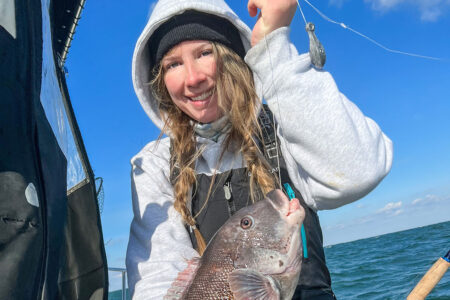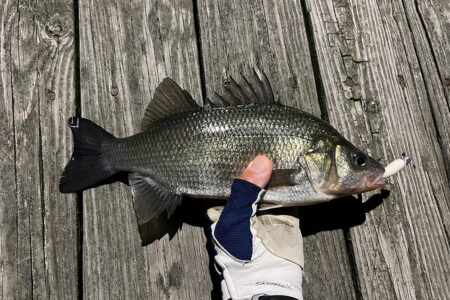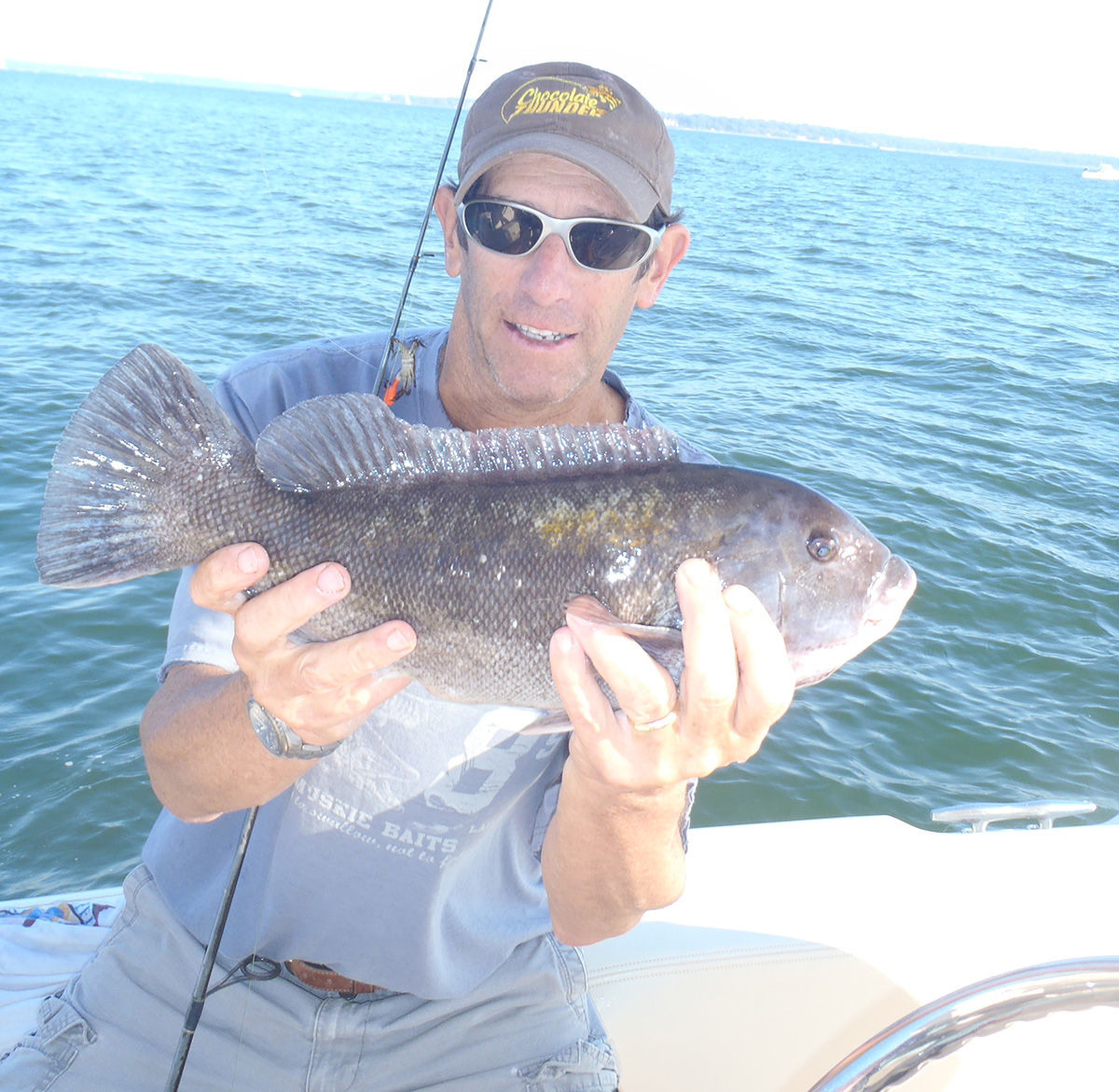
When I think about how far today’s tackle has come, I also recall how primitive our fishing tools were decades ago. Where blackfishing was concerned, terminal tackle consisted of Virginia hooks attached to short lengths of tarred cord. If you’re thinking this was fine twine coated with tar you’d be wrong. It was closer to thin rope soaked in tar. The theory was that the tarred cord offered protection from the rocks when blackfish turned their heads into structure, and to that end it was effective. However, can you imagine, in today’s world where many anglers insist on using fluorocarbon line because it is almost invisible, that we went blackfishing with thick and very visible terminal tackle? Well, we did, and we got away with it because there were so many more blackfish, and competition between the fish was fierce.
These days, we can rely on vastly better gear and a finesse approach to blackfishing. For example, a friend using a 3/8-ounce jig and light tackle hooked into and landed a 13-pound beast in 10 feet of water in Long Island Sound in 2016. Today, light tackle fishing for blackfish is possible, in part, because technology has improved our tackle, but also because sharpies have offered up intimate knowledge of blackfish behavior that has given us insight into how they live: movement, feeding, and growth that we never had before. This new knowledge helps us catch more blackfish because we have a much better understanding of where to be and when to be there, as well as how to tickle their fancy.
Although I abandoned the meat gear decades ago, up until recently I continued to use rather stout boat tackle. As the average size diminished I began thinking about ways to get more out of the fight without sacrificing the ability to muscle a better fish out of the rocks. Sure, I knew about the latest fad of blackfishing with jigs, but I never used them until last fall. Frankly, it seemed unnatural that a fish normally very wary of sudden movement would take a jig. Well, I was wrong. Although I’m often found experimenting with new ideas and tackle items, I was slow on the uptake with this one. However, the more I thought about it, the more it started to make sense. A jig with a piece of crab might look more natural than a big baited hook, dangling from a long thick leader.
Transition Time
Just as my boys pushed me, decade by decade “kicking and screaming” into computers, cell phones, cordless phones, and the latest-Kindle White, so too Rich Lazar gently nudged me towards light tackle and jigs for blackfish. Of course, I had to watch him out-fish me a few times before I gave in to instruction, but I got there. Although I use a 7-foot medium heavy rod and VS 150 when bucktailing for stripers and big summer blues in a boat, Lazar was adamant that this tackle might be a little too much for jigging blackfish. So, trying to be as obedient as possible I opted for a 7-foot light power spinning rod with parabolic bend and fast tip. A Van Staal 100 spooled with 20-pound test Sufix Performance Braid was matched to the rod, and I added a 15-pound mono leader to the running line.
Following the lead of my fearless leader, I asked Rich about the size of the jig-head and he said, “I use the lightest smallest jig I can get away with so that I can feel it better. Usually, I use a 3/8-ounce jig that is flat-sided because they seem to slip between the rocks better and are easier to get out.” He did not explain more about his feel of things. Still, just thinking about rough and tumble blackfishing turning into a finesse exercise gave me a headache.
Using light tackle might be compared to the finesse needed to paint a pin-stripe free hand on a car, whereas heavy gear is more like hitting a nail spike with a sledge hammer. There is no doubt that modern gear allows us to feel more and make subtle movements and adjustments to our presentations, but unlike stout tackle, light gear demands keener attention from the angler.
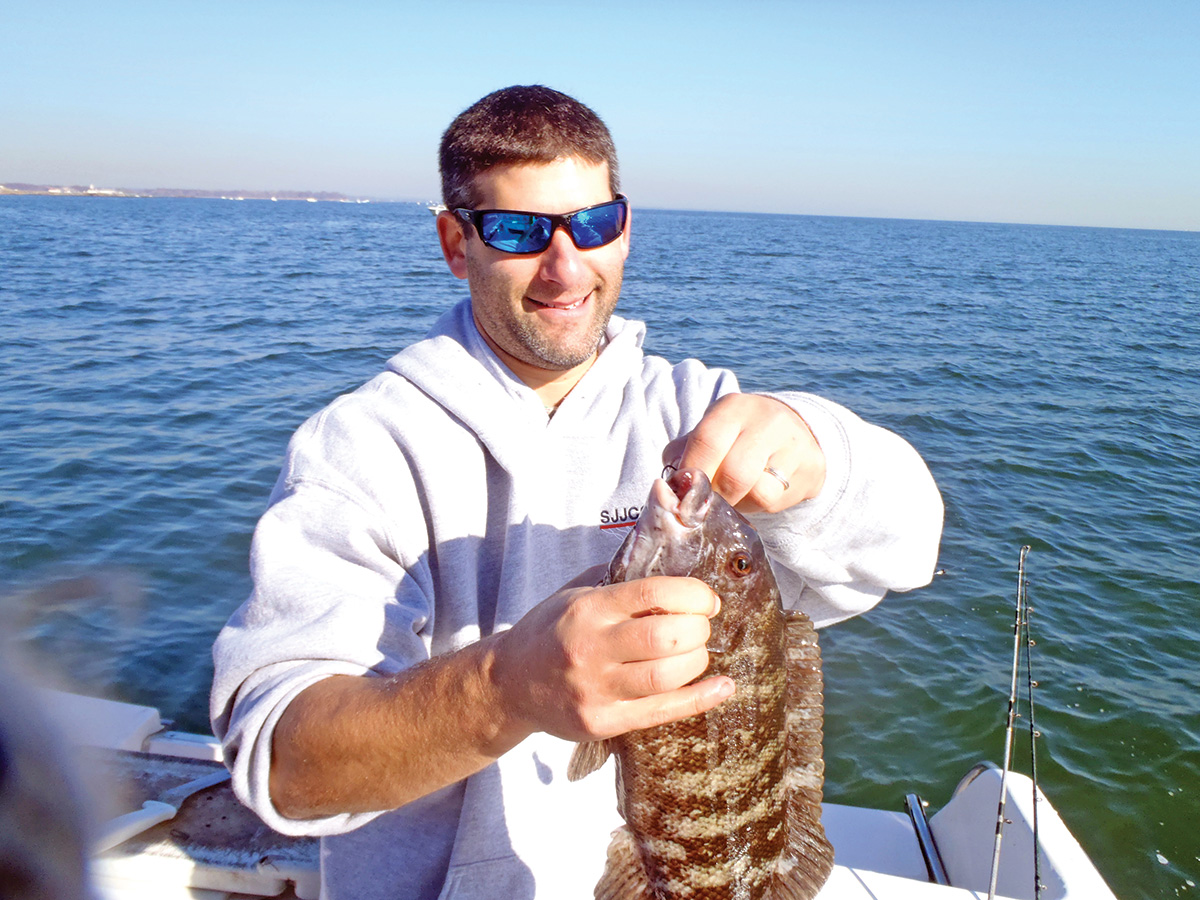
Baiting Up
Crabs are the favored autumn season bait. We’ve experimented with green crabs, Asian crabs, and fiddler crabs and found that all work well, although blackfish seem to prefer one over the other at certain times. We try to bring along at least two varieties. I can also tell you that, although considered a spring bait, clams work too. The 2017 fall was very mild, as you’ll recall, and there were lots of porgies around when blackfish season opened. So, I experimented. I tried a two-hook rig, one hook with clam and the other with crabs and, son-of-a-gun, I caught as many blackfish on clams as on crab. By the way, I caught big porgies and sea bass on crabs, too.
Different crabs are baited in different ways. For Asian and fiddler crabs, you can pretty much put the hook where you’d like. However, anglers have different ways to hook a green crab. Some cut a crab in half, remove the top shell and insist on leaving the legs on. They force the hook into the under-body and out again. Others, like myself, prefer to remove the upper shell and some of the legs and use the leg holes to put the hook in and then out another hole. Other anglers, who fish deep water reefs or around wrecks expect to catch big blackfish, use a whole crab and hook the bait in several ways. I also add an extra temptation. Before I lower the crab to the bottom I squeeze it gently in order to crack the shell and allow juices to flow out more easily.
The Technique
Fewer and smaller blackfish on the shallow feeding grounds has changed the feeding dynamics. Oh, and by the way, there are far fewer bergalls, which may or may not be a good thing. These days it’s usually leftover porgies that pick at the crabs in the autumn shallows. So, what does this mean to the modern angler equipped with light tackle and blackfish jigs? Instead of dozens of fish feeding in a small area, there may be only a handful, which may explain why a finesse approach is so successful. These days when a blackfish approaches a bait it’s probably alone, and there is no urgency to gobble it up. Therefore, the fish takes its time, sniffing and tasting. If the angler moves the crab too soon or too swiftly, the blackfish might scoot away; although I must admit that in this new age of light tackle blackfishing there are days when moving the jig and crab seems to stimulate more strikes than a static bait.
So, we use our ultra-sensitive tackle to feel for even the slightest hint that a blackfish is around the bait. Sometimes the nibbles are so light that it might be mistaken for the current or the swinging of the boat gently moving the jig off the spot, or even rolling off a very small rock onto sand or gravel. In fact, since our jigs are light, blackfish feel no more weight than that of a crab, and sometimes they pick up the bait and slowly swim off. The angler must be attentive, since the only hint of a bite is the line moving off. That happened to me quite a few times last fall. You also need to check your jigs often because blackfish are amazingly adroit at removing a crab bait from the hook even though the hook has been forced through the shell twice, or in one leg hole and out another. People, apparently are less adroit at this, which I conclude because I struggle to remove an old bait that has lost its juice and meat.
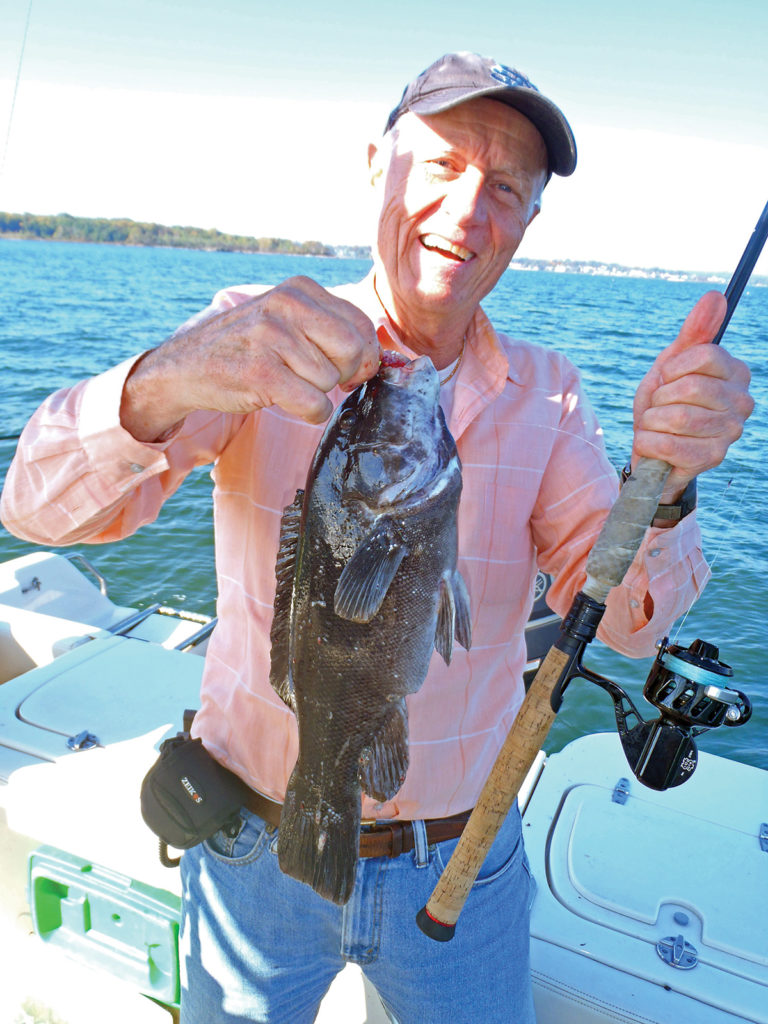
As mentioned above, some days the blackfish want the jig and crab stationary, but sometimes prefer a little motion. So, as part of our light-tackle finesse approach we jiggle the jig a bit. Sometimes this seems to shake them off their natural wariness, and they strike the bait hard. This subtle jig wiggling can only be done with very light sensitive tackle. There is a tendency to move the jig too much with stout tackle because the angler has trouble “feeling” jig/bait movements with heavy gear.
There have been lots of short blackfish in recent years, but that doesn’t diminish the fun; especially on light tackle, so you’ll be releasing more fish. Fortunately, blackfish are rugged fish so all we really need to do most times is simply remove the hook and gently toss sub-sized or unwanted fish into the briny. After the release, I urge you to take your time rebaiting. Wily blackfish easily steal a crab that is not securely baited. I know we all want to get our baits down to hook up again, but a few extra seconds carefully baiting-up can mean the difference between losing your crab on the first nibble or hooking that fish. Certainly a well-baited hook will force a blackfish to be a lot more persistent.
Once hooked, anglers using light gear can’t afford to be wishy-washy about the fight. The first order of business is to put a good bend in the rod and lift that fish away from the structure. Once you get it 3 or 4 feet off the bottom you can relax and enjoy the fight. It’s surprising how big a bend a 15-inch blackfish can put in a light rod. Light tackle shallow water blackfish is a blast and if you haven’t yet tried it I urge you to do so.

